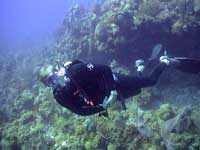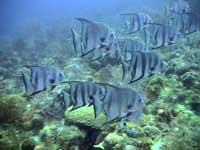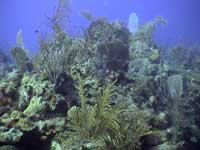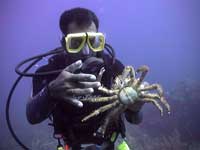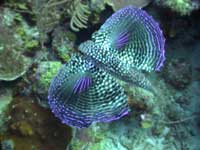
When we went diving on St. Kitts during the first week of our expedition (See December 20, 2000 journal), we discovered the reefs near the island were covered with algae. People were catching many of the fish that eat algae and the fertilizers from land were washing into the sea, making the algae grow too fast. Today we’re going to dive on some reefs farther from shore. Our hypothesis (educated guess) is that the further we get from shore, the less algae growth we’ll see on the reefs. That’s because we expect that further from shore, the fertilizer in the water is more diluted. Plus fishing on the further reefs may be less intense, since it’s harder to get to them. We’re going diving with VJ, a local dive instructor and guide from Guyana. Joining us is Captain Ayer, our ship’s captain, who is also a divemaster. VJ takes us far from shore, about two miles from land, and anchors the small dive boat. We put on our scuba equipment and jump into the water. The water is very clear, with underwater visibility of over 80 feet! As we slowly descend, a school of large fish swims right at us! Even though each fish is about one and one-half feet long, we’re not scared. These fish are called spadefish because their bodies are shaped like the spades you see on playing cards. The spadefish are not going to attack us. They’re apparently attracted to the air bubbles that we make as we breathe underwater. The spadefish swim in a couple of circles around our air bubbles, looking at them curiously, then they swim away. We swim down to the reef, 60 feet below the boat. Just as we suspected, the reefs out here are not covered with algae as the reefs near shore were. The corals also look healthier than the corals near shore. As we swim over the reef, we see a good variety of both hard and soft corals. Large purple and yellow sea fans gently sway back and forth with water currents. Even though St. Kitts was hit by hurricanes, the reef here is deep enough so these pretty sea fans were not destroyed as they were on Sandy Island (See January 1, 2001 journal). As we examine the corals, we suddenly hear a loud banging sound! VJ is clanking his air tank with a dive knife. He’s signaling that he wants to show us something. We quickly swim over. VJ is carefully holding a crab, trying to keep the creature from pinching him with its long claws. This is a spider crab. (It’s called a spider crab because its legs are kind of spidery.) Spider crabs hide in caves and holes in the reef, resting during the day. At night they come out and eat algae growing on the reef. After showing us, VJ gently puts the crab back in its hole in the reef. Even though we don’t notice any fish traps, we don’t see as many fish as we expected. We do see bigger fish, however, like the spadefish. We’re getting low on air so we turn around to start our swim back to the dive boat. Something on the reef catches my eye. I’m surprised to find a strange fish that would normally hide in the sea grasses, but instead is hiding in the coral. It’s a flying gurnard! As I wave over Mrs. Brown and Captain Ayer, the fish suddenly opens its "wings." Even though they have what look to be wings, these fish can’t fly. The wings are actually very large fins. Flying gurnards spread their colorful wings to make themselves look bigger. This sudden change of size may surprise and scare a predator, so the flying gurnard can escape as the predator tries to figure out what happened! VJ is pointing toward the boat, so we leave the flying gurnard and swim back to end our dive. |
The captain of the Nantucket Clipper, Captain Ayer, joins us as we investigate the coral reefs of St. Kitts.
A school of spadefish swims around us, checking out our air bubbles, as we swim down to the coral reef.
The coral reef here looks healthier than the reefs we saw closer to St. Kitts. Notice the variety of hard and soft corals we find growing here.
VJ carefully holds a spider crab. He’s trying to show us the crab while keeping it from pinching him with its long claws!
This flying gurnard spreads its colorful "wings" to make itself look bigger. Normally these wing-like fins are folded next to the side of the fish. This flying gurnard is about 10 inches long. |
|||||||||||||||||||||
|
||||||
